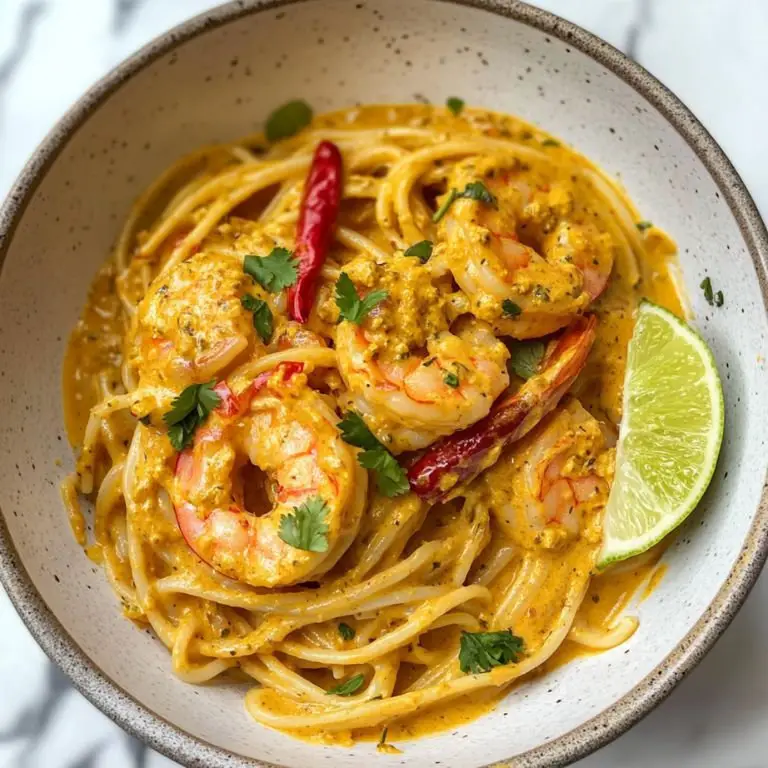If you’re looking to shake up your regular pasta night with something vibrant, aromatic, and just a little bit fancy, this Coconut Curry Prawn Pasta is exactly what you need. This dish brings together the bold, fragrant flavors of Thai-style coconut curry and the irresistible tenderness of prawns, all tossed into a perfectly cooked bed of linguine. It’s one of those prawn dinner recipes that feels indulgent yet is surprisingly easy to whip up—think creamy prawn pasta meets Southeast Asian spice. Whether you're craving a new go-to for weeknight meals or something exciting for date night in, this dish delivers big flavor with minimal effort.
Coconut Curry Prawn Pasta
Prep Time 10 minutes mins
Cook Time 20 minutes mins
Total Time 30 minutes mins
Course Main Course
Cuisine Italian
Servings 2 generous portions
Large pot for boiling pasta
Deep skillet or sauté pan for making the sauce and cooking the prawns
Tongs for tossing the pasta
Microplane (optional) for grating garlic or ginger
Alternatives A wok can easily sub in for the skillet, and spaghetti or fettuccine are great stand-ins if linguine isn’t on hand—this prawn linguine recipe is adaptable!
- 250 g linguine or spaghetti linguine works beautifully here for a slurp-worthy bite
- 1 tbsp olive oil
- 1 tbsp butter optional, for extra richness
- 4 cloves garlic minced
- 1 small red chili finely sliced (optional, for heat)
- 1 tsp grated ginger
- 300 g raw prawns peeled and deveined (jumbo or large prawns preferred)
- 1 tsp curry powder
- 1/2 tsp turmeric
- 1 can 400ml coconut milk (full-fat for creaminess)
- 1 tbsp fish sauce or soy sauce
- Juice of half a lime
- Salt and pepper to taste
- Fresh coriander and lime wedges for garnish
Cook the linguine
Bring a pot of salted water to a boil and cook the pasta until just al dente. Reserve a bit of pasta water before draining.
Sauté aromatics
In a large skillet, heat olive oil and butter over medium heat. Add garlic, ginger, and chili. Cook until fragrant, about 1 minute.
Add the prawns
Toss in the raw prawns and sprinkle with curry powder and turmeric. Sauté until the prawns turn pink and opaque—this should only take 2-3 minutes.
Build the sauce
Lower the heat and pour in the coconut milk. Add fish sauce and lime juice. Let it simmer for 5–7 minutes, allowing the flavors to meld and the sauce to thicken slightly.
Combine pasta and sauce
Add the drained linguine to the skillet. Toss everything together, adding a splash of reserved pasta water if needed to loosen the sauce.
Season and finish
Taste and adjust with salt, pepper, or an extra squeeze of lime. Garnish with chopped coriander and serve with lime wedges.
Pairings
This tropical, curry-infused pasta is bold enough to stand alone, but if you're feeling fancy, serve it with a chilled glass of Sauvignon Blanc or a lightly sparkling rosé. A side of grilled vegetables or a cucumber mint salad would also make a fresh, cooling contrast. If you're leaning toward fusion, pair it with crispy garlic naan for scooping up every last bit of sauce.
FAQs
1. Can I use shrimp instead of prawns?
Absolutely! Prawns and shrimp are often used interchangeably in seafood pasta recipes. Just make sure they're peeled and deveined. If you're searching for shrimp pasta recipes easy enough for weeknights, this one fits the bill.
2. Which type of pasta works best?
Linguine is ideal because it hugs the creamy coconut sauce, but spaghetti or fettuccine also work well. For fans of prawn spaghetti or even prawn noodle recipes, rice noodles can be a great gluten-free alternative.
3. Is this dish healthy?
Yes, especially if you’re looking for healthy prawn recipes. The dish is dairy-free, rich in lean protein, and packed with anti-inflammatory spices like turmeric and ginger.
4. Can I make this ahead?
You can make the sauce in advance, but prawns are best cooked fresh to keep them juicy. You can prep this as part of your easy prawn recipes collection for fast dinners throughout the week.
5. What kind of prawns should I use?
Go for large, raw prawns—either fresh or thawed from frozen. Tail-on adds visual flair, but tail-off makes it easier to eat. Avoid precooked prawns, as they can get rubbery.
